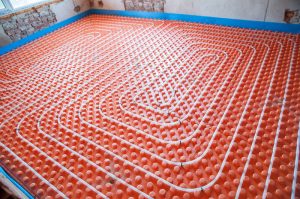 Have you ever considered a radiant heating system for your home? This type of heat differs from radiators, baseboard heating, or forced-air central heating in some pretty significant ways. Below we will discuss what radiant heating is, and how it works – so you can make an informed decision before adding it to your home. If you’re a person who suffers from perpetually chilly feet – this might be exactly what you’ve been looking for. If the idea of toasty toes excites you, keep reading!
Have you ever considered a radiant heating system for your home? This type of heat differs from radiators, baseboard heating, or forced-air central heating in some pretty significant ways. Below we will discuss what radiant heating is, and how it works – so you can make an informed decision before adding it to your home. If you’re a person who suffers from perpetually chilly feet – this might be exactly what you’ve been looking for. If the idea of toasty toes excites you, keep reading!
What Exactly Is Radiant Heating?
In a radiant heating system, heat is supplied either to panels in the walls or ceiling – or to the floors in a room.
Rather than forcing hot air through a duct system, radiant heating is similar to feeling the heat from a hot stovetop burner from a couple of feet away.
Radiant heating is actually more efficient than baseboard heat or forced-air heating, since there’s no loss of heat through the duct system.
It’s also preferable for people who suffer from allergies, since the ducts in a forced-air central heat system can harbor dust and mold.
Hydronic systems rely on hot liquids to transmit heat and can use a solar water heater, a gas or oil-fired boiler, or even a wood-fired boiler – which is a real plus for anyone who’s off the power grid or lives in an area with high electricity rates.
Floor Radiant Heating
In some newer homes, “dry” radiant heating in floors has become popular.
In these systems, a series of tubes or cables are mounted under the subfloor, between the floor joists, with a layer of reflective insulation underneath to help direct the heat up through the floor.
In some instances, a liquid tubing setup is fitted into diffusers that help disperse heat evenly across the entire floor. One design incorporates a plywood subfloor material that’s pre-fitted with aluminum heat diffuser plates and grooves to install tubing.
Floor radiant heating systems rely on convection, the natural tendency for warm air to rise and colder, heavier air to stay low. Ceramic tile floors are an excellent choice for these systems, as the ceramic material conducts and retains heat well.
Wall-Mounted Radiant Panels
These systems use either electric elements or hot water tubing through the walls to disperse heat, though leakage can be a concern with hot water tubing.
It’s a less popular system, as it’s not very efficient for whole house heating – however, it can be a good fit for a room addition (as opposed to trying to run ductwork and registers to the new room).
Is Radiant Heating Right for My House?
Radiant heating has been around since the ancient baths of Turkish and Roman times – and was even incorporated into some of Frank Lloyd Wright’s turn-of-the-century homes.
For new home construction, it certainly makes sense and is becoming more popular.
As a retrofit, it depends on how much you’re willing to spend and how extensively you can modify your home. The technology is evolving rapidly, and some novel retrofit kits are available for either hydronic or electrical radiant heating (provided your home has a basement or crawlspace).
Radiant heating is certainly an intriguing idea, and one that can bring a new level of comfort to a home that forced-air or other systems can’t match.
Contact Evans Plumbing, Inc. for radiant heating systems in Twin Falls, ID today!


